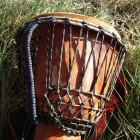Recently I have been emailing a school student working on a music project, answering questions about West African rhythms. His latest query asked for exercises or tips for mastering polyrhythms.
Polyrhythms, in a nutshell, are combinations of rhythms using different time signatures, played together.
Here are some prototypical polyrhythms:
With any 4/4 pattern…the Afro-Latin clave:
x – – x – – x – x – – x – – x –
Note the predominant triplet feel in the swing of the clave, played over a 4/4 bar.
With any 6/8 pattern, you can overlay a binary cross-rhythm. The following is a common kenkeni part for 6/8 rhythms like Soli…
x – o – o – x – o – o –
or Dununba:
O – x – O – x – O – x –
My latest deep exploration, inspired by the Drum in the Sun camp in Thailand run by Michael Pluznick and Tim Dabrowski, plays with the elasticity of a single djembe pattern, in the field between the artificial polarities of 4/4 and 6/8. For example, try each of these as 6, then as 4, then back and forth, with more subtlety, in the middle:
[right, left: G, D = bass; g, d = tone; P, T = slap]
Sunu
as 6: g T P D P d g T P D P d
as 4: g – T P – D P d g – T P – D P d
Djole
as 6: G d g D P T G d g D P T
as 4: G – d g D – P T G – d g D – P T
4/4 bell: x – x – x – x – x – x – x – x –
One further note on polyrhythmic timing. There are two ways to overlap 6 on 4. For example in Djole (which is normally played in 4) instead of leaving spaces as in the 4 variation above, you can instead stretch the triplet notes of the 6 variation evenly across the phrase, so for example the G d g will take the same time as the x – x – of the bell pulse.
As always, mastering these overlapping timings in ensemble can be tricky. Try it with a drum track for practice, and explore the elastic space available with your solo practice.
